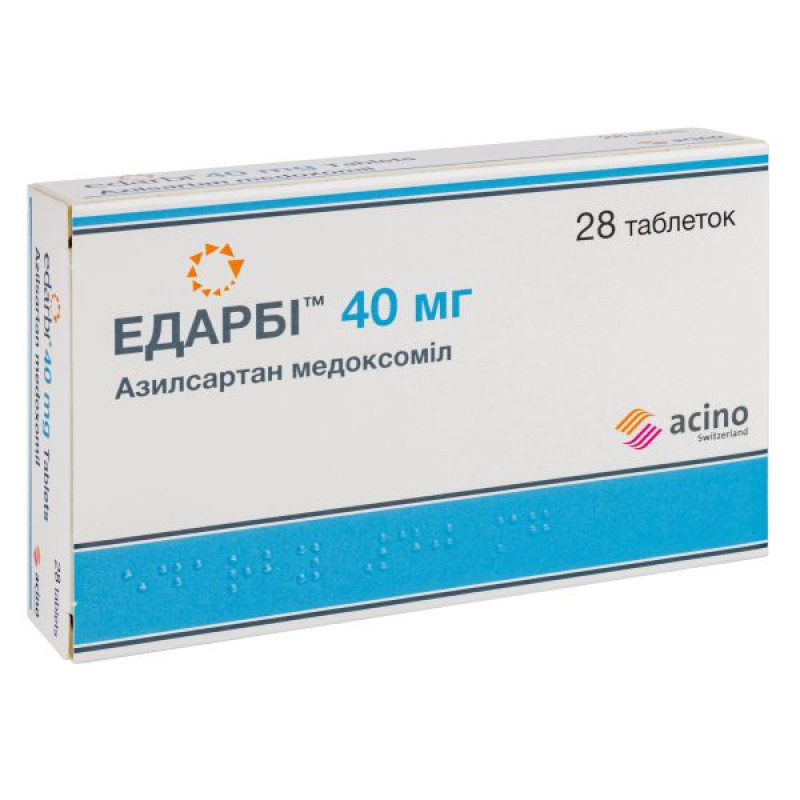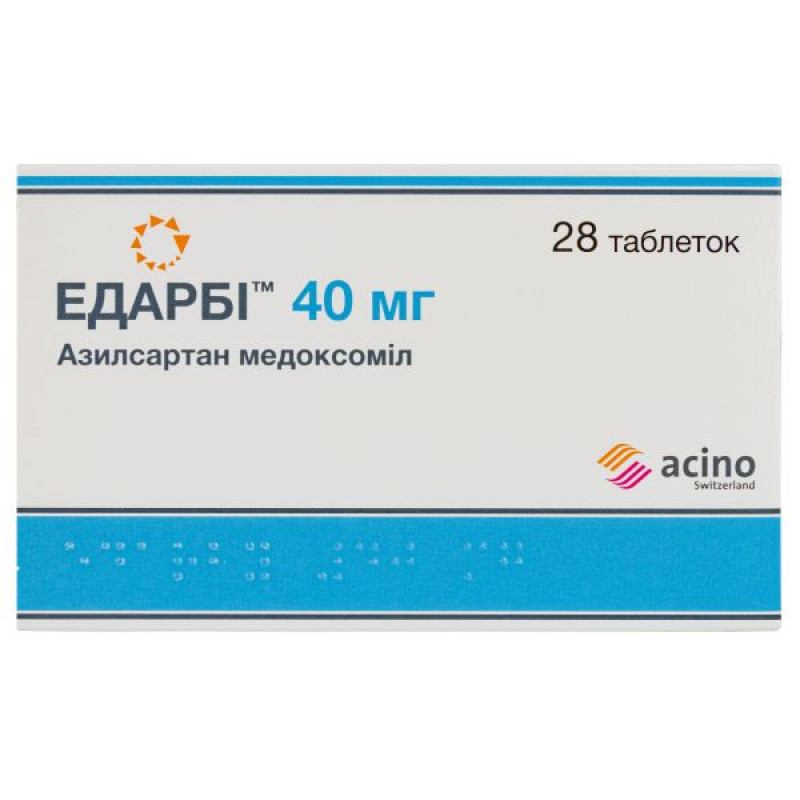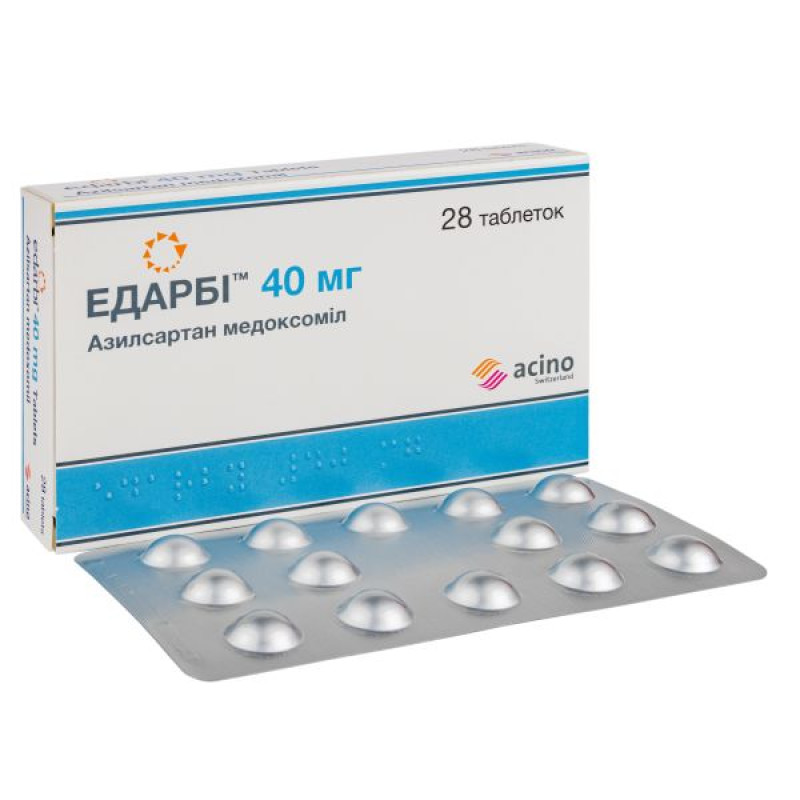Edarbi tablets 40 mg blister No. 28

Instructions for Edarbi tablets 40 mg blister No. 28
Composition
active ingredient: azilsartan medoxomil;
1 tablet of Edarbi 20 mg contains 21.34 mg of azilsartan medoxomil potassium, which is equivalent to 20 mg of azilsartan medoxomil;
1 tablet of Edarbi 40 mg contains 42.68 mg of azilsartan medoxomil potassium, which is equivalent to 40 mg of azilsartan medoxomil;
1 tablet of Edarbim 80 mg contains 85.36 mg of azilsartan medoxomil potassium, which is equivalent to 80 mg of azilsartan medoxomil;
Excipients: mannitol (E 421); fumaric acid; sodium hydroxide; hydroxypropylcellulose; croscarmellose sodium; microcrystalline cellulose; magnesium stearate; purified water.
Dosage form
Pills.
Main physicochemical properties:
20 mg tablets: white or almost white tablets, engraved with “ASL” on one side and “20” on the other side;
40 mg tablets: white or almost white tablets, engraved with “ASL” on one side and “40” on the other side;
80 mg tablets: white or almost white tablets, engraved with “ASL” on one side and “80” on the other side.
Pharmacotherapeutic group
Drugs that affect the renin-angiotensin system, angiotensin II receptor antagonists, are simple.
ATX code C09C A09.
Pharmacological properties
Pharmacodynamics. Azilsartan medoxomil is an active prodrug for oral administration. The prodrug is rapidly converted to the active molecule azilsartan, which, by blocking the binding of angiotensin II to AT1 receptors in many tissues, acts as a selective antagonist of the effects of angiotensin II (see section "Pharmacokinetics"). Angiotensin II is the main blocking agent of the renin-angiotensin system; the effects of angiotensin II include vasoconstriction, stimulation of aldosterone synthesis and release, stimulation of cardiac function, and stimulation of sodium reabsorption in the kidneys.
Blockade of AT1 receptors leads to inhibition of the negative feedback effect of angiotensin II on renin secretion, but the increase in plasma renin activity and the increase in systemic angiotensin II levels that occur as a result of receptor blockade do not prevent the development of the antihypertensive effect of azilsartan.
Pharmacokinetics: After oral administration, azilsartan medoxomil is rapidly hydrolyzed in the gastrointestinal tract and/or during absorption to the active substance (azilsartan).
In vitro studies show that the enzyme carboxymethylenebutenolidase is involved in the hydrolysis processes in the intestinal tract and liver. Plasma esterases are also involved in the hydrolysis of azilsartan medoxomil to azilsartan.
Absorption: Based on plasma concentrations of azilsartan, the estimated absolute oral bioavailability of azilsartan medoxomil is approximately 60%. After oral administration of azilsartan medoxomil, peak plasma concentrations (Cmax) of azilsartan are reached within 1.5 to 3 hours (see Dosage and Administration). Food does not affect the bioavailability of azilsartan.
Distribution: The volume of distribution of azilsartan is approximately 16 liters. Azilsartan is extensively (>99%) bound to plasma proteins, primarily serum albumin. Plasma protein binding is unchanged over a range of concentrations well above those achieved at recommended doses.
Biotransformation. Metabolic breakdown of azilsartan results in the formation of two major metabolites. The major metabolite in plasma is formed by O-dealkylation and is designated as metabolite M-II. The minor metabolite, which is formed by decarboxylation, is designated as metabolite M-I. Systemic exposure levels of the major and minor metabolites in humans were approximately 50% and less than 1% of the exposure level of azilsartan, respectively. M-I and M-II do not have an additional effect on the pharmacological action of azilsartan medoxomil. Metabolism of azilsartan is primarily mediated by the enzyme CYP2C9.
Elimination: Following oral administration of 14C-labeled azilsartan medoxomil, approximately 55% of the radioactivity was excreted in the feces and approximately 42% in the urine. Approximately 15% of the drug was excreted in the urine as unchanged azilsartan. The plasma half-life of azilsartan is approximately 11 hours, and renal clearance is approximately 2.3 mL/min. Steady-state concentrations of azilsartan are reached within 5 days, and there is no accumulation in plasma with multiple once-daily dosing.
Linearity/non-linearity: A dose-dependent relationship was observed for azilsartan exposure after single or multiple doses over the dose range of 20 to 320 mg of azilsartan medoxomil.
Characteristics in specific patient subgroups.
Children: The pharmacokinetics of azilsartan in children (under 18 years of age) have not been studied.
Renal impairment. In patients with mild, moderate and severe renal impairment, the total exposure of azilsartan (AUC) increased by 30%, 25% and 95%, respectively. In patients with end-stage renal disease on dialysis, no increase in exposure was observed (+5%). However, there is no clinical experience in patients with severe renal impairment or end-stage renal disease. Azilsartan is not removed from the systemic circulation by haemodialysis.
Hepatic impairment: Treatment of patients with mild (Child-Pugh Class A) or moderate (Child-Pugh Class B) hepatic impairment with Edarbi for up to 5 days resulted in a small increase in azilsartan exposure (1.3- to 1.6-fold increase in AUC). Edarbi has not been studied in patients with severe hepatic impairment.
Gender: No significant differences in the pharmacokinetics of azilsartan were found between men and women. No dose adjustment is necessary based on the patient's gender.
Race: No significant differences in the pharmacokinetics of azilsartan were observed between white and black patients. No dose adjustment is necessary based on race.
Indication
Treatment of essential hypertension in adults.
Contraindication
Hypersensitivity to the active substance or to other components of the drug.
Pregnant women or women planning to become pregnant (see section “Use during pregnancy or breastfeeding”).
Patients with diabetes mellitus or renal impairment (GFR < 60 mL/min/1.73 m2) should not use Edarbi with drugs containing aliskiren.
Interaction with other medicinal products and other types of interactions
Combinations are not recommended.
Lithium. Reversible increases in serum lithium concentrations and reversible increases in toxicity have been observed with concomitant use of lithium and angiotensin-converting enzyme (ACE) inhibitors. A similar effect may be observed with angiotensin II receptor blockers. Due to the lack of experience with the concomitant use of azilsartan medoxomil and lithium, this combination is not recommended. If concomitant use of these drugs is necessary, careful monitoring of serum lithium levels is recommended.
Combinations that should be used with caution.
Nonsteroidal anti-inflammatory drugs (NSAIDs), including selective cyclooxygenase-2 (COX-2) inhibitors, acetylsalicylic acid at doses >3 g/day, and nonselective NSAIDs.
Concomitant use of NSAIDs (i.e. selective COX-2 inhibitors, e.g. acetylsalicylic acid at doses >3 g/day and non-selective NSAIDs) and angiotensin II receptor blockers may result in attenuation of the hypotensive effect of the latter. In addition, concomitant use of angiotensin II receptor blockers and NSAIDs may increase the risk of worsening renal function and an increase in serum potassium. Therefore, it is recommended to ensure adequate hydration of the patient and monitoring of renal function at the beginning of treatment.
Potassium-sparing diuretics, potassium supplements, salt substitutes containing potassium, and other substances that can increase potassium levels in the blood.
Potassium-sparing diuretics, potassium supplements, salt substitutes containing potassium and other drugs (e.g. heparin) may increase blood potassium levels when used concomitantly. Serum potassium levels should be monitored as necessary.
Additional information.
Clinical trial data have shown that dual blockade of the renin-angiotensin-aldosterone system (RAAS) with the combined use of ACE inhibitors, angiotensin II receptor blockers or aliskiren increases the risk of hypotension, hyperkalemia, and worsening renal function (including acute renal failure) compared with monotherapy with an active RAAS agent (see sections "Contraindications" and "Special warnings and precautions for use").
No clinically significant drug interactions were reported in studies of azilsartan medoxomil or azilsartan in combination with amlodipine, antacids, chlorthalidone, digoxin, fluconazole, glyburide, ketoconazole, metformin, and warfarin.
Azilsartan medoxomil is rapidly hydrolyzed by esterases in the gastrointestinal tract and/or during absorption to the active substance azilsartan. In vitro studies indicate a low likelihood of interactions based on esterase inhibition.
Application features
Edarbi should be used with caution in patients with hypertension and severe renal impairment, congestive heart failure or renal artery stenosis, as there is no experience with the use of the drug in these patients (see sections 5.2 and 5.2).
A very strong decrease in blood pressure in patients with ischemic cardiomyopathy or ischemic cerebrovascular disorders can lead to myocardial infarction or stroke.
Dual blockade of the RAAS. The combined use of ACE inhibitors, angiotensin II receptor blockers or aliskiren increases the risk of hypotension, hyperkalemia and deterioration of renal function (including acute renal failure). Therefore, dual blockade of the RAAS due to the combined use of ACE inhibitors, angiotensin II receptor blockers or aliskiren is not recommended (see sections 5.1 and 5.2). If dual blockade therapy is necessary, it should be carried out under close medical supervision and monitoring of renal function, electrolyte levels and blood pressure. ACE inhibitors should not be used in patients with diabetic nephropathy together with angiotensin II receptor blockers.
Kidney transplantation: There is no experience with the use of Edarbi in patients who have recently undergone kidney transplantation.
Hepatic impairment: Edarbi has not been studied in patients with severe hepatic impairment and is therefore not recommended for use in this group of patients (see sections 5.2 and 5.2).
Hypotension in patients with volume and/or salt depletion. In patients with severe volume and/or salt depletion (e.g., patients with diarrhea, vomiting, or patients receiving large doses of diuretics), symptomatic hypotension may occur after initiation of treatment with Edarbi. Measures should be taken to compensate for hypovolemia before initiating treatment or treatment should be initiated under close medical supervision. An initial dose of 20 mg should also be considered.
Primary hyperaldosteronism: Patients with primary hyperaldosteronism usually do not respond to antihypertensive medicinal products that inhibit the RAAS. Therefore, the use of Edarbi is not recommended in these patients.
Hyperkalemia. Based on experience with other drugs that affect the RAAS, the concomitant use of Edarbi with potassium-sparing diuretics, potassium supplements, salt substitutes containing potassium, or other drugs that may increase blood potassium levels (e.g. heparin) may lead to increases in blood potassium levels in hypertensive patients (see section 4.5). Elderly patients, patients with renal insufficiency, patients with diabetes, and/or patients with other comorbidities are at increased risk of hyperkalemia (which may be fatal). Potassium levels should be monitored as necessary.
Aortic and mitral valve stenosis, obstructive hypertrophic cardiomyopathy. Treatment of patients with aortic or mitral valve stenosis or with hypertrophic obstructive cardiomyopathy requires special caution.
Lithium. As with other angiotensin II receptor blockers, the concomitant use of Edarbi with lithium is not recommended (see section 4.5).
Use during pregnancy or breastfeeding
Pregnancy. The drug should not be used in pregnant women or women planning to become pregnant. If pregnancy is confirmed during treatment with the drug, its use should be immediately discontinued and replaced with another drug approved for use in pregnant women.
There are no data from the use of azilsartan medoxomil in pregnant women. Animal studies have shown reproductive toxicity.
Epidemiological data do not indicate a risk of teratogenicity following exposure to ACE inhibitors during the first trimester of pregnancy, but a small increase in risk cannot be excluded. In the absence of controlled epidemiological data on the risk associated with angiotensin II receptor blockers, a risk cannot be excluded for this class of drugs. Unless continued therapy with angiotensin II receptor blockers is considered essential, patients planning pregnancy should be changed to alternative antihypertensive treatments which have an established safety profile for use in pregnancy.
If angiotensin II receptor blockers are used during the second trimester of pregnancy, ultrasound examination of the fetus to assess renal function and ossification of the skull is recommended.
Infants whose mothers have taken angiotensin II receptor blockers should be closely observed for hypotension (see sections 4.3 and 4.4).
Breast-feeding Azilsartan medoxomil is not recommended for use during breast-feeding due to lack of adequate data. Alternative treatments with better established safety profiles during breast-feeding are preferable, especially while nursing a newborn or preterm infant.
Fertility: There are no data on the effects of azilsartan medoxomil on human reproductive function. In nonclinical studies, azilsartan did not affect the reproductive function of male and female rats.
Ability to influence reaction speed when driving vehicles or other mechanisms
Azilsartan medoxomil has no or negligible influence on the ability to drive and use machines. However, dizziness or fatigue may occur.
Method of administration and doses
Edarbim is intended for oral use; tablets can be taken with or without food (see section "Special instructions").
The recommended starting dose is 40 mg once daily.
For patients whose blood pressure is not adequately controlled at this dose, the dose may be increased to the maximum recommended dose of 80 mg once daily.
A sustained antihypertensive effect is achieved within 2 weeks of treatment. The maximum effect is achieved after 4 weeks of drug therapy.
If adequate blood pressure control is not achieved with Edarbi monotherapy, additional blood pressure reduction may be achieved with combination therapy with other antihypertensive agents, including diuretics (e.g. chlorthalidone and hydrochlorothiazide) and calcium channel blockers.
Elderly patients (aged 65 years and older) do not require adjustment of the starting dose of Edarbi. However, for patients aged 75 years and older who are at risk of hypotension, a dose of 20 mg should be considered (see section 5.2).
Renal impairment. Edarbi should be used with caution in patients with hypertension and severe renal impairment or end-stage renal disease, as there is no experience in such patients. Azilsartan is not removed from the systemic circulation by hemodialysis. Patients with mild or moderate renal impairment do not require dose adjustment.
Hepatic impairment. Studies on the use of Edarbi in patients with severe hepatic impairment have not been conducted, therefore the drug is not recommended for use in this group of patients.
Since experience with Edarbi in patients with mild to moderate hepatic impairment is limited, it is recommended to closely monitor the condition of such patients and consider using the drug at an initial dose of 20 mg.
Intravascular volume depletion: In patients with possible intravascular volume depletion or salt depletion (e.g., patients with vomiting, diarrhea, or patients receiving large doses of diuretics), Edarbi should be administered under close medical supervision, and an initial dose of 20 mg should be considered.
Negroid patients. No dose adjustment is necessary, although these patients experience a less pronounced decrease in blood pressure than patients of other races. This is usually the case with other angiotensin II receptor blockers and ACE inhibitors. This population may require more frequent dose increases of Edarbi and concomitant medications.
Children. The safety and efficacy of the drug in children and adolescents (under 18 years of age) have not been established. There are no data on the use of the drug.
Overdose
Symptoms. Based on the pharmacological properties, the main manifestations of overdose would be expected to be symptomatic hypotension and dizziness. In controlled clinical trials in healthy volunteers, Edarbi was administered at doses up to 320 mg once daily for 7 days. These doses were well tolerated by the study subjects.
Treatment: In cases of symptomatic hypotension, replacement therapy should be initiated and vital signs monitored. Azilsartan is not removed by hemodialysis.
Side effects
Adverse reactions are classified according to the following frequency: very common (≥ 1/10), common (> 1/100 and < 1/10), uncommon (> 1/1000 and < 1/100), rare (> 1/10000 and < 1/1000), very rare (< 1/10000), including isolated cases. Within each system organ class, adverse reactions are listed in order of decreasing clinical significance.
From the nervous system.
Common: dizziness.
From the vascular system.
Uncommon: hypotension.
Common: diarrhea.
Uncommon: nausea.
On the skin and subcutaneous tissue.
Uncommon: rash, itching.
Rare: angioedema.
On the part of the musculoskeletal system and connective tissue.
Uncommon: muscle spasms.
General violations.
Uncommon: fatigue, peripheral oedema.
Laboratory studies.
Common: increased blood creatine phosphokinase levels.
Uncommon: increased blood creatinine, increased blood uric acid/hyperuricemia.
Description of selected adverse reactions.
During concomitant use of Edarbi and chlorthalidone, the frequency of increased blood creatinine levels and hypotension increased from uncommon to common.
During the combined use of Edarbi and amlodipine, the incidence of peripheral edema increased from uncommon to common, but was lower than that observed with amlodipine monotherapy.
Laboratory studies.
Serum creatinine. In randomized, placebo-controlled monotherapy studies, the incidence of serum creatinine elevations following treatment with Edarbi did not differ from that in the placebo group. Concomitant use of Edarbi and diuretics, such as chlorthalidone, resulted in a higher incidence of creatinine elevations. This observation is consistent with known facts for other angiotensin II receptor blockers and ACE inhibitors. Elevations in creatinine during concomitant use of Edarbi and diuretics were associated with a greater reduction in blood pressure than when either of these drugs was used alone. Most episodes of creatinine elevation were transient or did not progress with continued treatment. After discontinuation of treatment, creatinine levels returned to normal or near normal values in most cases.
Uric acid: A small mean increase in serum uric acid levels was observed with Edarbi compared to placebo (10.8 μmol/L vs. 4.3 μmol/L).
Haemoglobin and hematocrit: In placebo-controlled monotherapy studies, small decreases in haemoglobin and hematocrit (approximately 3 g/l and 1 vol%, respectively) were observed. This effect has also been observed with other RAAS inhibitors.
Expiration date
3 years.
Storage conditions
Does not require any special storage conditions. Store in original packaging. Keep out of reach of children!
Incompatibility
Not described.
Packaging
14 tablets in a blister. 1 or 2 or 4 blisters in a cardboard box.
Vacation category
According to the recipe.
Producer
Takeda Ireland Ltd, Ireland/Takeda Ireland Ltd, Ireland.
Address
Bray Business Park, Kilruddery, Co. Wicklow, Ireland.
There are no reviews for this product.
There are no reviews for this product, be the first to leave your review.
No questions about this product, be the first and ask your question.







